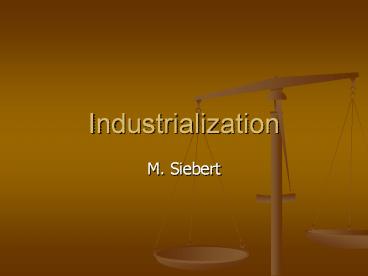Industrialization M. Siebert Building the 1st - PowerPoint PPT Presentation
1 / 47
Title:
Industrialization M. Siebert Building the 1st
Description:
Industrialization M. Siebert Building the 1st Transcontinental Railroad Pacific Railway Act of 1862 U.S. Government hired Union Pacific and Central Pacific ... – PowerPoint PPT presentation
Number of Views:35
Avg rating:3.0/5.0
Title: Industrialization M. Siebert Building the 1st
1
Industrialization
- M. Siebert
2
Building the 1st Transcontinental Railroad
- Pacific Railway Act of 1862 U.S. Government
hired Union Pacific and Central Pacific Railway
Company to extend railways across the United
States. - Central Pacific Started in Sacramento, CA
- Union Pacific Started in Omaha, NE
- The 2 railroad companies met in Promontory, Utah
to drive the Golden Spike on May 10, 1869
3
(No Transcript)
4
Promontory, Utah May 10, 1869
5
The Workers
- Majority of workers were Chinese and Irish
immigrants - The working conditions for all, was very poor and
strenuous! - The working conditions were tough because of the
difficult terrain and weather conditions
6
Who did the Railroad Impact?
- Native Americans (called it the Iron Horse)
- Helped Westward expansion
- Made trade much easier
- Hurt the farmers economically because of the
higher costs for farmers - They made deals with wealthy businessmen (became
corrupt) - Became crucial to the U.S. economy
7
Legislation
- Interstate Commerce Act of 1887 put in place
for Govt to supervise railroad activities - Led to more financial problems (railroads were
forced out of business, which led to the Panic of
1893) - This caused the Large Firms to start buying up
the railways, which paved the way for Big
Businesses
8
Industrialization Factors
- Unskilled and semi-skilled labor in abundance
- New, talented entrepreneurs
- Oil
- Inventions
- New technology that allows mass production
- Bessemer Process
- Railroads
- Changes in business strategy
- Vertical Integration Horizontal Consolidation
- Social Darwinism
9
The Reorganization of Work
Frederick W. Taylor The Principles of Scientific
Management (1911)
10
The Reorganization of Work
The Assembly Line
11
Vertical and Horizontal Integration
12
Standard Oil Co.
13
Regulating the Trusts
- 1877 ? Munn. v. IL
- 1886 ? Wabash, St. Louis Pacific
Railroad Company v. IL - 1890 ? Sherman Antitrust Act
- in restraint of trade
- rule of reason loophole
- 1895 ? US v. E. C. Knight Co.
14
The Gospel of WealthReligion in the Era of
Industrialization
- Wealth no longer looked upon as bad.
- Viewed as a sign of Gods approval.
- Christian duty to accumulate wealth.
- Should not help the poor.
Russell H. Conwell
15
On Wealth
- The Anglo-Saxon race is superior.
- Gospel of Wealth (1901).
- Inequality is inevitable and good.
- Wealthy should act as trustees for their
poorer brethren.
Andrew Carnegie
16
Cornelius Commodore Vanderbilt
Cant I do what I want with my money?
17
William Vanderbilt
- The public be damned!
- What do I care about the law? Haint I got the
power?
18
New Financial Businessman
- The Broker
- J. Pierpont Morgan
19
New Business CultureThe American Dream?
- Protestant (Puritan) Work Ethic
- Horatio Alger 100 novels
Is the idea of the self-made man a MYTH??
20
The Protectors of Our Industries
21
The Changing American Labor Force
22
Child Labor
23
Child Labor
24
Management vs. Labor
Tools of Management
Tools of Labor
- scabs
- Pinkertons
- lockout
- blacklisting
- yellow-dog contracts
- Collective Bargaining
- informational picketing
- organized strikes
25
A Striker Confronts a SCAB!
26
Knights of Labor
Terence V. Powderly
An injury to one is the concern of all!
27
Goals of the Knights of Labor
- Eight-hour workday.
- Workers cooperatives.
- Worker-owned factories.
- Abolition of child and prison labor.
- Increased circulation of greenbacks.
- Equal pay for men and women.
- Safety codes in the workplace.
- Prohibition of contract foreign labor.
- Abolition of the National Bank.
28
Labor Unrest 1870-1900
29
The Great Railroad Strike of 1877
30
Haymarket Riot (1886)
McCormick Harvesting Machine Co.
31
Haymarket Martyrs
32
The American Federation of Labor 1886
Samuel Gompers
33
How the AF of L Would Help the Workers
- Catered to the skilled worker.
- Represented workers in matters of national
legislation. - Maintained a national strike fund.
- Evangelized the cause of unionism.
- Prevented disputes among the many craft unions.
- Mediated disputes between management and labor.
- Pushed for closed shops.
34
Homestead Steel Strike
(1892)
Homestead Steel Works
The Amalgamated Association of Iron Steel
Workers
35
A CompanyTown Pullman, IL
36
Pullman Cars
A Pullman porter
37
The Pullman Strike of 1894
38
The Pullman Strike of 1894
Government by injunction!
39
The Socialists
Eugene V. Debs
40
International Workers of the World (Wobblies)
41
Big Bill Haywood of theIWW
- Violence was justified to overthrow capitalism.
42
I W W
43
Mother Jones The Miners Angel
- Mary Harris.
- Organizer for theUnited MineWorkers.
- Founded the SocialDemocratic Party in 1898.
- One of the founding members of the I. W. W. in
1905.
44
The Formula
unions violence strikes socialists
immigrants
anarchists
45
Labor Union Membership
46
The Rise Decline of Organized Labor
47
Discussion Questions
- What were the cost and benefits of the industrial
transformation of the Post- Civil War era? - Was the growing class division of the time a
threat to American democracy? Why or why not?































